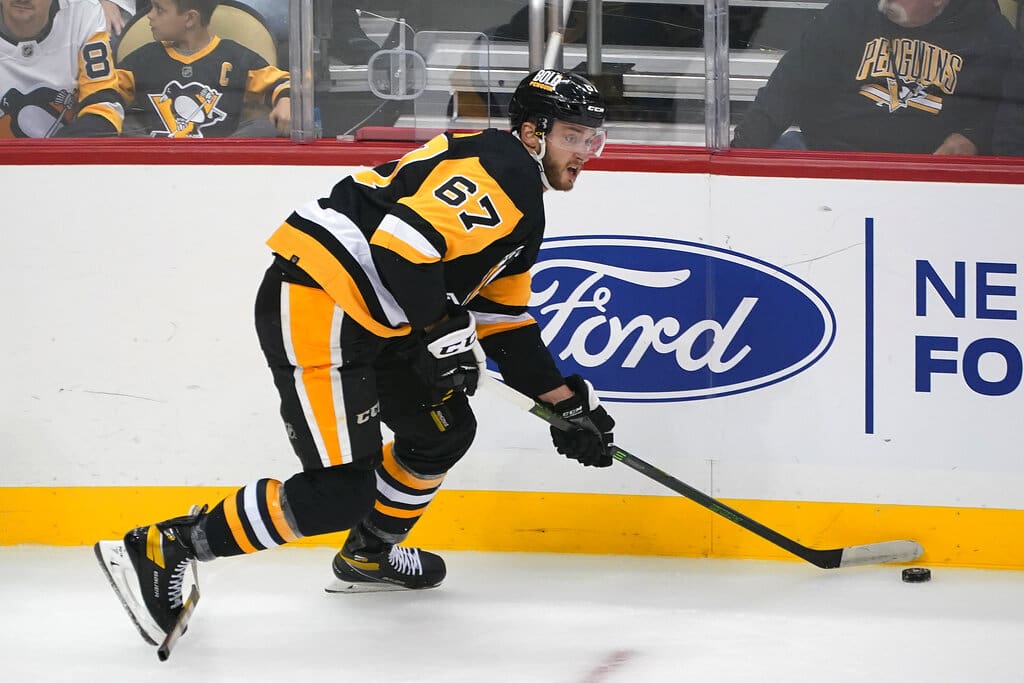Penguins
Penguins One-Timers: Judging the Changes, One More to Make?

The Pittsburgh Penguins have tinkered with the lineup since president of hockey operations/GM Kyle Dubas submitted the final roster, and the team bolted sideways out of the starting gate. Those little changes have made big differences, and a four-game winning streak has negated losses in five of six.
The wild swings have been an issue over the last few seasons, but the recent Penguins evolution suggests they may have a handle on the wild swings. Their recent structured, low-event style and wins are a departure from the high-event roller coaster they were riding.
There’s power in controlling the low-event games. There’s also an advantage to limiting scoring chances, especially when your side has Sidney Crosby and Evgeni Malkin getting (or creating) a few of those chances.
Perhaps the older Penguins now have the attention span and patience for the structured game that has eluded them.
Penguins Lineup Changes/Results
The bottom six crew has undergone two lineup changes. Seemingly insignificant, they’ve paid dividends. Radim Zohorna helped Lars Eller and Drew O’Connor reverse course and did so immediately.
When Zohorna is on the ice, the Penguins’ stats explode. According to NaturalStatTrick.com, Zohorna’s metrics are a 60% Corsi, 66% of goals scored, a 63.5 expected goals-for, nearly 57% of scoring chances, and 64% of high-danger chances.
A third line that can put up those numbers would be the best third line the Penguins have iced since Shawn Michaels sat in the front row to cheer the HBK line (Hagelin-Bonino-Kessel) on the Penguins’ run to the 2016 Stanley Cup.
Conversely, before Zohorna’s arrival, the line had stats ranging from 34 to 40%. That’s a full 20 or more point swing.
“I think Lars Eller’s line has added an offensive dimension. I think ‘Big Z’ has really helped there,” Sullivan said. “(Drew O’Connor) his game has continued to grow and develop. Lars is such a smart player.”
The fourth line has not undergone a statistical revival in the three games with Vinnie Hinostroza, but the eye test with Hinostroza over Jeff Carter.
For example, the fourth line had only one scoring chance in the 4-0 shutout over the Buffalo Sabres on Saturday. However, they allowed none. That tracks in line with the numbers when Jeff Carter is on the line, though Hinostroza does not have a 35+ contract with a full no-movement clause that has fans seething.
Hinostroza is clearly a few steps quicker than Carter and provides a boost on the forecheck, but offensively, the line has been scoreless and quiet in two of three games without Carter.
One big plus and one improvement.
Penguins Defense Upgrade?
The blue liners have undergone a few changes, as well. Ryan Shea has quietly seized his chance to be an NHL player. You don’t notice Shea often, and that is by his and the team’s design. He was a top-pair offensive defenseman in the AHL but was told to simplify his game for the NHL.
The Penguins coaches urged him to strip away the risk. He’s done that. He moves well enough and moves the puck properly. Shea doesn’t commit turnovers or get beat in physical battles, and he moves the puck expeditiously.
However, to keep Shea in the lineup, defenseman P.O Joseph has been served a healthy supply of press box nachos. There’s been no sign of wobble in Shea’s game, which could permanently relegate Joseph to seventh defenseman.
In order to give Joseph another shot, coaches moved Shea to the right side in the 10-2 win over San Jose. However, Joseph was the one player who had a bad game. Ok, the one Penguins player who had a rough night.
Joseph was returned to the land of healthy scratches, and Chad Ruhwedel has remained on the right side.
The pair have metrics well below average, including 44% of scoring chances, 42% expected goals-for, and a horrendous 23% of high-danger scoring chances.
Given that the forward crews are enjoying significantly positive numbers, the third pairing’s abysmal numbers indicate plenty of room for improvement. Perhaps the positive is that they’ve been on the ice for only two goals against (but only on the ice for one goal for).
We may find out more on Monday about defenseman John Ludvig, who was inserted on the right side but lasted only two periods in his NHL debut before suffering a concussion on a full-speed open-ice hit that he delivered on Dallas Stars forward Radek Faksa.
The Penguins’ third-pairing is the last area on the team to upgrade to competence.
Power Plays?
Sure, something can be made of the Penguins’ power play foibles this season. However, the Penguins are also drawing minimal penalties. Only three teams in the league average fewer power plays per game than the Penguins.
The Penguins aren’t taking many penalties, either.
Yet the Penguins’ inability to draw penalties probably points to a few flaws in their game, even as they’re winning. Penalties come from pressure, winning individual battles, physical engagement, and making the other team chase the game.
It’s difficult to determine how a team that is winning games and looking good doing so is not drawing more penalties. But it’s something to watch.












